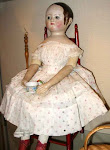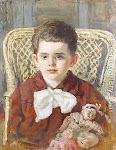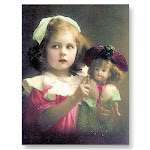
—Fifteenth-century carol, Reginald Thorne Davies, Medieval English Lyrics: A Critical Anthology, 1972.
 A group of English carols set down in the fifteenth century preserves evidence of a ritual contest between boys bearing branches of holly and girls bearing ivy. The red-berried holly, symbolizing light, warmth, and light, was meant to prevail over the black-fruited ivy, which signified the dark and cold of winter. Thus, ivy remained outside the door while holly was carried triumphantly into the hall.
A group of English carols set down in the fifteenth century preserves evidence of a ritual contest between boys bearing branches of holly and girls bearing ivy. The red-berried holly, symbolizing light, warmth, and light, was meant to prevail over the black-fruited ivy, which signified the dark and cold of winter. Thus, ivy remained outside the door while holly was carried triumphantly into the hall. " A Midwinter Night's Dream," Album Cover, Loreena McKennitt
" A Midwinter Night's Dream," Album Cover, Loreena McKennitt "Tiss Me," Kate Greenaway
"Tiss Me," Kate Greenaway No era in history however, has influenced the way in which we celebrate Christmas, quite as much as the Victorians. Before Victoria’s reign started in 1837 nobody in Britain had heard of Santa Claus , and no Christmas cards were ever sent.
No era in history however, has influenced the way in which we celebrate Christmas, quite as much as the Victorians. Before Victoria’s reign started in 1837 nobody in Britain had heard of Santa Claus , and no Christmas cards were ever sent. 
The Christmas tree was introduced in Britain during the Georgian period, in the early 1800s following the personal union with the Kingdom of Hanover, by Charlotte of Mecklenburg-Strelitz, Queen to King George III.
 Prince Albert decorated the private family Christmas tree with strings of dried fruit, bonbons, wax dolls and painted unshelled walnuts.
Prince Albert decorated the private family Christmas tree with strings of dried fruit, bonbons, wax dolls and painted unshelled walnuts.“I must now seek in the children an echo of what Ernest, his brother, and I were in the old time, of what we felt and thought; and their delight in the Christmas tree is not less than ours used to be.”- Prince Albert…

 A Victorian family's most prized ornament was the Nuremberg angel atop the tree. It had wings of spun glass, a crinkled gold skirt, and a wax or bisque face. Angels or cherubs represented the Victorian ideal of childlike or womanly innocence.
A Victorian family's most prized ornament was the Nuremberg angel atop the tree. It had wings of spun glass, a crinkled gold skirt, and a wax or bisque face. Angels or cherubs represented the Victorian ideal of childlike or womanly innocence.The Gifts
 At the start of Victoria's reign, children's toys tended to be handmade and expensive, generally restricting availability to the "rich folk". With the Industrial Revolution however, came mass production, which brought with it games, dolls, books and clockwork toys all at a more affordable price. Affordable that is to "middle class" children. In a "poor child's" Christmas stocking, which first became popular from around 1870, only an apple, orange and a few nuts could be found.
At the start of Victoria's reign, children's toys tended to be handmade and expensive, generally restricting availability to the "rich folk". With the Industrial Revolution however, came mass production, which brought with it games, dolls, books and clockwork toys all at a more affordable price. Affordable that is to "middle class" children. In a "poor child's" Christmas stocking, which first became popular from around 1870, only an apple, orange and a few nuts could be found.  Stockings by Goullaud
Stockings by Goullaud
 "Christmas Morning"
"Christmas Morning" "Pantins of Pierrot and Columbine," Victorian Dancing Puppets
"Pantins of Pierrot and Columbine," Victorian Dancing Puppets
 Charles Dickens wrote books like "Christmas Carol", published in 1843, which encouraged rich Victorians to redistribute their wealth by giving money and gifts to the poor - Humbug! These radical middle class ideals eventually spread to the not-quite-so-poor as well.
Charles Dickens wrote books like "Christmas Carol", published in 1843, which encouraged rich Victorians to redistribute their wealth by giving money and gifts to the poor - Humbug! These radical middle class ideals eventually spread to the not-quite-so-poor as well.
Kissing Under the Mistletoe
 Another Christmas tradition that began during the Victorian era, was that of suspending sprigs of mistletoe from the ceiling…
Another Christmas tradition that began during the Victorian era, was that of suspending sprigs of mistletoe from the ceiling…Those who met under it could claim a kiss. This was away around the social restrictions of the times. No unmarried girl could spend time alone with a young man if they were courting; then they would be chaperoned. At Christmas, under the mistletoe, a lover could taste their sweetheart's lips, perhaps for the first time. The number of kisses allowed under each plant depended on the number of berries. Each time a kiss was given, a berry was taken off. No more berries, no more kisses!
Carolers would stop at houses to sing and play the popular carols :
1843 - O Come all ye Faithful
1848 - Once in Royal David's City
1851 - See Amid the Winters Snow
1868 - O Little Town of Bethlehem
1883 - Away in a Manger
…in the hopes to be invited for a warm drink.
Dickens might not have invented Christmas, but he is credited with the great revival of Christmas traditions in the Victorian era, which have continued in one form or the other to the present day in all English-speaking countries around the globe.

"And I do come home at Christmas. We all do, or we all should. We all come home, or ought to come home, for a short holiday -- the longer, the better -- from the great boarding-school, where we are for ever working at our arithmetical slates, to take, and give a rest. As to going a visiting, where can we not go, if we will, where have we not been, when we would, starting our fancy from our Christmas Tree!"













































.jpg)













































































What can I say, love the images and the music - though I thought it might be Loreena at first - one of my favourites. Great, great post, really enjoyed ad several of those pictures are absolute crackers (excuse the pun). Thanks.
ReplyDeleteMuy interesante la historia y las imágenes fantásticas!!!
ReplyDeleteHi Marta, That is a great post on Christmas past and the vintage photos with the ornaments. I am a collector of antigue Christmas ornaments also from the Victorian period to about the 1930s. Im always on the hunt for antique Christmas goodies. Thanks for sharing all this information. And also thanks for stopping by. Have a good week....Julian
ReplyDeleteThank you dear friends!...I wasn't sure about this post, after all its only mid June..LOL!
ReplyDeleteBut its one of our Victorian legacies, so I had to include a bit of Xmas is June...
Bisous
Marta
Thank you so much for this wonderful blog!
ReplyDeletewww.maijaandme.blogspot.com
www.tjetjatrot.blogspot.com
maija
Marta de veras que es fantastico, y sobre todo me encanta esa epoca navideña. Gracias por esas hermosas imagenes.
ReplyDeleteHola Marta!!!
ReplyDeleteQué maravilla de secuencias históricas tan bien ilustradas nos has preparado!!!
Una satisfacción conocer origenes de tradiciones propias de la Navidad!!!
Un abrazo enorme!!!
Thank you for your support! Its very encouraging.
ReplyDeleteHugs
Marta